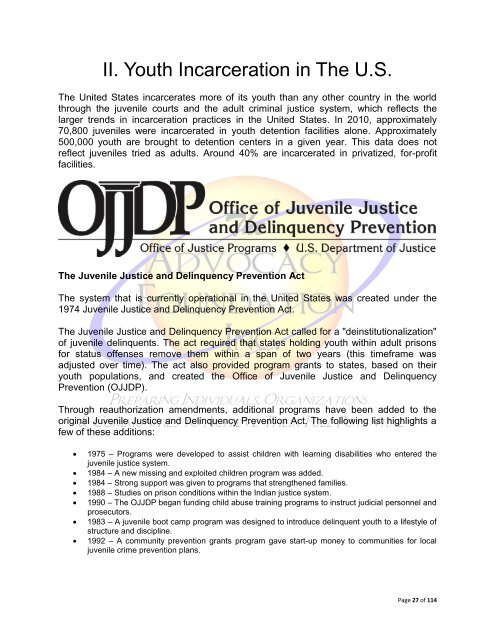African-American Youth in The Juvenile Justice System
African-American Youth in The Juvenile Justice System
African-American Youth in The Juvenile Justice System
You also want an ePaper? Increase the reach of your titles
YUMPU automatically turns print PDFs into web optimized ePapers that Google loves.
II. <strong>Youth</strong> Incarceration <strong>in</strong> <strong>The</strong> U.S.<br />
<strong>The</strong> United States <strong>in</strong>carcerates more of its youth than any other country <strong>in</strong> the world<br />
through the juvenile courts and the adult crim<strong>in</strong>al justice system, which reflects the<br />
larger trends <strong>in</strong> <strong>in</strong>carceration practices <strong>in</strong> the United States. In 2010, approximately<br />
70,800 juveniles were <strong>in</strong>carcerated <strong>in</strong> youth detention facilities alone. Approximately<br />
500,000 youth are brought to detention centers <strong>in</strong> a given year. This data does not<br />
reflect juveniles tried as adults. Around 40% are <strong>in</strong>carcerated <strong>in</strong> privatized, for-profit<br />
facilities.<br />
<strong>The</strong> <strong>Juvenile</strong> <strong>Justice</strong> and Del<strong>in</strong>quency Prevention Act<br />
<strong>The</strong> system that is currently operational <strong>in</strong> the United States was created under the<br />
1974 <strong>Juvenile</strong> <strong>Justice</strong> and Del<strong>in</strong>quency Prevention Act.<br />
<strong>The</strong> <strong>Juvenile</strong> <strong>Justice</strong> and Del<strong>in</strong>quency Prevention Act called for a "de<strong>in</strong>stitutionalization"<br />
of juvenile del<strong>in</strong>quents. <strong>The</strong> act required that states hold<strong>in</strong>g youth with<strong>in</strong> adult prisons<br />
for status offenses remove them with<strong>in</strong> a span of two years (this timeframe was<br />
adjusted over time). <strong>The</strong> act also provided program grants to states, based on their<br />
youth populations, and created the Office of <strong>Juvenile</strong> <strong>Justice</strong> and Del<strong>in</strong>quency<br />
Prevention (OJJDP).<br />
Through reauthorization amendments, additional programs have been added to the<br />
orig<strong>in</strong>al <strong>Juvenile</strong> <strong>Justice</strong> and Del<strong>in</strong>quency Prevention Act. <strong>The</strong> follow<strong>in</strong>g list highlights a<br />
few of these additions:<br />
<br />
<br />
<br />
<br />
<br />
<br />
<br />
1975 – Programs were developed to assist children with learn<strong>in</strong>g disabilities who entered the<br />
juvenile justice system.<br />
1984 – A new miss<strong>in</strong>g and exploited children program was added.<br />
1984 – Strong support was given to programs that strengthened families.<br />
1988 – Studies on prison conditions with<strong>in</strong> the Indian justice system.<br />
1990 – <strong>The</strong> OJJDP began fund<strong>in</strong>g child abuse tra<strong>in</strong><strong>in</strong>g programs to <strong>in</strong>struct judicial personnel and<br />
prosecutors.<br />
1983 – A juvenile boot camp program was designed to <strong>in</strong>troduce del<strong>in</strong>quent youth to a lifestyle of<br />
structure and discipl<strong>in</strong>e.<br />
1992 – A community prevention grants program gave start-up money to communities for local<br />
juvenile crime prevention plans.<br />
Page 27 of 114

















